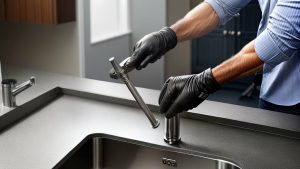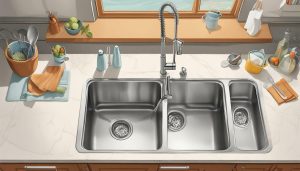Is your kitchen sink drain causing you problems? Don’t worry; you can easily replace it yourself! Proper maintenance is critical to keep your kitchen functioning smoothly, and replacing a kitchen sink drain is a simple DIY project that anyone can do.
In this guide, we will take you through the step-by-step process of replacing a kitchen sink drain, from assessing the problem to testing the new one. By the end of this guide, you will feel confident in your ability to tackle this project on your own.
Key Takeaways:
- Replacing a kitchen sink drain is a simple DIY project that anyone can do.
- Proper maintenance is critical to keep your kitchen functioning smoothly.
- From assessing the problem to testing the new one, this guide will take you through the step-by-step process of replacing a kitchen sink drain.
Assessing the Problem and Gathering Tools
If you’re experiencing issues with your kitchen sink drain, it’s crucial to assess the problem before starting the replacement process. Here’s a step-by-step guide to help you identify the issue and gather the necessary tools for the job.
Step 1: Identify the Problem
The first step in replacing a kitchen sink drain is to identify the problem. Start by inspecting the drain area and checking for any visible damage or leaks. If the issue is not apparent, run water in the sink and observe the drainage. A slow or clogged drain may indicate a problem with the drain assembly.
Step 2: Gather the Necessary Tools
Before starting the replacement process, it’s important to gather the necessary tools. Here is a list of tools that you may need:
| Tools | Materials |
|---|---|
| Adjustable wrench | Plumber’s putty |
| Pliers | Silicone sealant |
| Screwdriver | Teflon tape |
| Putty knife | New sink drain assembly |
By gathering these tools beforehand, you can ensure a smoother and more efficient replacement process.
Now that you’ve assessed the problem and gathered the necessary tools, let’s move on to the next step of preparing the work area.
Preparing the Work Area
Before replacing a kitchen sink drain, it is important to prepare the work area properly. This includes turning off the water supply and removing any items from under the sink, creating a clear workspace for the replacement process to take place.
One of the first steps in kitchen sink plumbing replacement is to gather the necessary tools, such as a bucket, pliers, putty knife, and a new sink drain kit. These tools will be essential in removing and installing the sink drain.
It is also important to check the condition of the existing plumbing in the sink. If there is any rust or damage, it may be necessary to replace the entire plumbing assembly.
Removing the Old Sink Drain
Now that you have gathered your tools and assessed the problem, it is time to remove the old kitchen sink drain. Follow these steps:
- First, turn off the water supply by shutting off the valves under the sink.
- Next, place a bucket or container beneath the sink to catch any water that may leak out of the drain pipes.
- Remove any items from under the sink and detach the drain pipes connected to the sink drain assembly. You may need to use a pipe wrench to loosen and disconnect stubborn parts.
- Now, loosen the lock nut that connects the drain assembly to the sink and lift out the old drain assembly.
Pro tip: If any parts are difficult to remove, try using a penetrating oil such as WD-40 to loosen them up. Be patient and gentle to avoid damaging any components.
Installing the New Sink Drain
With the old sink drain removed, it’s time to install the new one. This step-by-step guide will help you with the process:
- Apply plumber’s putty: Roll plumber’s putty into a thin snake-like shape and place it around the underside of the flange. Ensure that it’s evenly distributed around the flange’s circumference.
- Attach the new drain: Insert the new drain assembly into the sink hole, making sure it fits snugly. Then, thread the mounting and lock nuts onto the drain assembly and tighten them with pliers.
- Create a secure connection: Connect the P-trap to the tailpiece of the sink drain. Tighten the compression nuts with pliers, but be careful not to overtighten them or they could crack.
Once you’ve completed these steps, check your connections to ensure they are tight, but not too tight. Any cross-threading or overtightening could lead to leaks.
Tips:
- Ensure that the sealing washer and gasket are properly installed before attaching the new drain assembly.
- Double-check that the new drain assembly is level with the sink.
- Avoid using too much plumber’s putty as it can cause the excess to seep out and create a mess.
- Use silicone caulk around the edge of the sink hole to create an additional seal.
Following these steps and tips will help you successfully install a new sink drain for your kitchen.
Checking for Leaks and Testing
After installing the new sink drain, it’s important to check for leaks and ensure that everything is working properly.
Start by turning on the water and letting it run for a few minutes. Pay close attention to the area around the drain to see if any leaks are present. If you detect any leaks, try tightening the connections or reapplying plumber’s putty as needed.
If everything looks good, fill the sink with water and let it sit for a few minutes. Then, drain the water and check again for any leaks. If no leaks are detected, you’re good to go!
If you do find a leak, however, don’t panic. Sometimes leaks can be caused by small issues like loose connections or improperly applied putty. Try tightening the connections or reapplying putty and see if that solves the problem.
If the leak persists, you may need to take apart the drain assembly and start again. It may be frustrating, but taking the time to properly fix any leaks will save you from bigger headaches down the line.
Remember, DIY sink drain replacement can be a rewarding project that saves you money and keeps your kitchen functioning smoothly. With proper preparation, tools, and techniques, you can replace your kitchen sink drain in no time!
Cleaning up and Finishing Touches
Now that the new sink drain is successfully installed, it’s time to clean up the work area and add some finishing touches to ensure your kitchen sink functions smoothly. Follow these steps:
- Wipe down the sink thoroughly, paying special attention to the area around the new drain assembly.
- Organize any items stored under the sink and make sure they are not interfering with the drain pipes.
- If you were replacing a clogged sink drain, run some hot water to flush out any remaining debris.
- Test the sink to ensure proper drainage and check for any leaks that might have occurred during the installation process.
- If leaks are detected, troubleshoot the problem by checking the putty seal and tightening any loose connections or nuts.
Cleaning up and adding finishing touches may seem like minor steps, but they can make a big difference in the overall appearance and function of your kitchen sink. By taking a few extra minutes to tidy up the work area, you’ll have a new sink drain that looks and works like a charm.
Maintenance Tips for Long-Lasting Sink Drains
Proper maintenance is key to ensuring your newly installed kitchen sink drain lasts for years to come. Follow these simple tips to keep your sink drain running smoothly:
- Regular cleaning: Wipe down the sink and drain stopper after each use to prevent buildup of debris and potential clogs.
- Avoid pouring certain substances down the drain: Cooking oil, grease, and coffee grounds can all cause clogs in your pipes over time. Dispose of these substances in the trash instead.
- Use a drain guard: A simple mesh or plastic drain guard can catch food scraps and other debris before they go down the drain, helping to prevent clogs.
- Treat your drains occasionally: Pouring a mixture of baking soda and vinegar down the drain once a month can help to dissolve any buildup of grease or other substances.
- Be proactive: If you notice slow drainage, tackle the issue right away rather than waiting for it to become a major problem.
By following these maintenance tips, you’ll save yourself time and hassle in the long run. A little bit of effort can go a long way in keeping your kitchen sink drain in top shape!
Conclusion
Replacing a kitchen sink drain may seem like a daunting task, but with this step-by-step guide, it can be done with ease. Remember to assess the problem and gather the necessary tools before beginning, and prepare the work area for a smooth process. Removing the old sink drain and installing the new one requires attention to detail, but the result is a leak-proof and functioning sink. Don’t forget to check for leaks and do some testing, and add the finishing touches by cleaning up the work area and maintaining your sink drain for long-lasting use.
By following these instructions, you can save money on plumber fees and feel accomplished in tackling this DIY project. A properly functioning kitchen sink is essential for everyday use, and with proper maintenance, you can avoid any future problems. Don’t be intimidated – with the knowledge gained from this guide, you can have a perfectly functioning kitchen sink drain in no time.
FAQ
Q: Can I replace my kitchen sink drain myself?
A: Yes, you can replace your kitchen sink drain yourself by following the step-by-step guide provided in this article.
Q: What tools do I need to replace a kitchen sink drain?
A: Some tools you will need include pliers, a wrench, plumber’s putty, and a screwdriver.
Q: How long does it take to replace a kitchen sink drain?
A: The time it takes to replace a kitchen sink drain may vary depending on your skill level and the complexity of the project, but it usually takes about 1-2 hours.
Q: Do I need to turn off the water supply before replacing the sink drain?
A: Yes, it is important to turn off the water supply before replacing the sink drain to avoid any water leaks or accidents.
Q: Can I use any type of plumber’s putty for the installation?
A: It is recommended to use a high-quality plumber’s putty that is specifically designed for sink installations to ensure a secure and leak-proof seal.
Q: What should I do if I notice leaks after installing the new sink drain?
A: If you notice leaks after installing the new sink drain, you may need to double-check the connections and tighten any loose fittings. If the problem persists, it is advisable to seek professional assistance.
Q: How often should I clean my kitchen sink drain to prevent clogs?
A: It is recommended to clean your kitchen sink drain every few weeks to prevent clogs and maintain proper drainage. Regular cleaning can help remove any build-up of debris or residue that can lead to clogs.
Q: What materials or substances should I avoid putting down the sink drain?
A: To prevent clogs and damage to your sink drain, it is best to avoid putting grease, oils, coffee grounds, eggshells, and fibrous materials (such as potato peels) down the drain. These items can cause blockages and hinder proper drainage.
Q: Can I use chemical drain cleaners to clear a clogged sink drain?
A: It is generally not recommended to use chemical drain cleaners as they can be harsh on your plumbing and may cause damage. Instead, try using a plunger or a natural drain cleaner solution. If the clog persists, it is best to consult a professional plumber.

It’s me, Amber Hayden, the heart and soul behind SagarmathaOnlineMedia.com. From a young age, I’ve been head over heels for everything home-related, from interior decor to gardening. I’m the type who can’t resist a well-crafted piece of furniture, and I firmly believe that a home isn’t complete without a pet or two. But it’s not just about creating pretty spaces for me. I’m all about making homes that tell a story reflecting the people living there. SagarmathaOnlineMedia.com is my way of sharing this passion with you. Whether you’re looking for tips to jazz up your living room, advice on pet care, or ideas to make your garden bloom, I’m here to help. So, let’s embark on this journey together and make your house a home!



